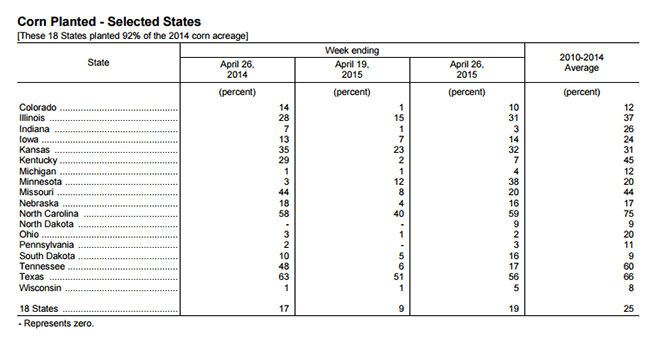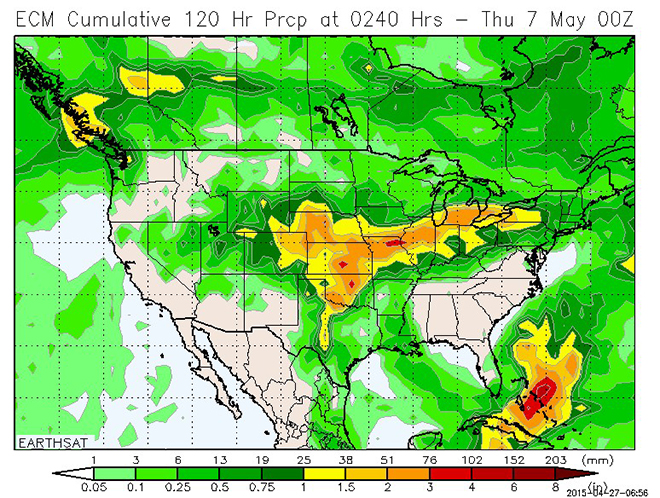Another week of spring planting's come and gone, and the last 7 days saw farmers make a much bigger stride with corn planting than the previous 2 weeks, and that speedy pace is expected to last through at least the next week, forecasters say.
Monday's weekly USDA-NASS Crop Progress report shows farmers have 19% of the nation's corn crop in the ground. That's a 10% jump over last week but remains 6% behind the normal pace. The last week of progress has this year slightly ahead of 2014, with farmers in states like Illinois and Iowa doubling their progress. Strides were even longer in states like Minnesota, where farmers went from 12% to 38% complete, according to Monday's report.

Thus far, emergence numbers are slow to trickle out and echo planting progress in general for corn; 2% of the nation's crop has poked through versus the previous average of 6% by this week. Soybean planting got underway in the last week, too, with 2% of the crop in the ground versus 3% a year ago and the normal pace of 4% by this week.
"Corn planting is moving rapidly in the western Corn Belt where many farmers are wrapping up this week. The slow and problem area is in the mid-South and the Delta," says Kluis Commodities market analyst and grain broker Al Kluis.
Planting progress this week will be fueled by a warming trend coupled with less frequent rainfall; some parts of the Corn Belt may not see moisture again through the end of this week, forecasters say.
"Some areas in Iowa are likely to reach 80+ by Thursday. The six- to 10- and 11- to 15-day forecast is for a lot of rain to move across the western Corn Belt and move in to the eastern Corn Belt by May 10 to 12. The stormy pattern with the normal zonal flow will bring frequent rain fronts across the country through mid-May," says meteorologist David Tolleris of WXRisk.com. Adds Kyle Tapley, senior ag meteorologist with MDA Weather Services: "Across nearly the entire Corn Belt, dry weather yesterday marked the start of at least a six-day planting window, which should allow corn planting to make huge progress. While temperatures will begin the week below normal across much of the Midwest, especially in southern areas, a gradual warming trend will occur throughout the week, with above-normal temperatures expected in northern and western areas by the end of the week. Warm weather should become even more widespread across the Midwest in the six- to 10-day period, but wetter weather will likely lead to a slowdown in planting."
While the warming and drying trend is good news for some, it's not so great for others. The Kansas City area and points throughout the western Corn Belt and central Plains are hurting for rainfall, and while the general trend has been one with increasing chances of spotty rainfall in that latter region for the last couple of weeks, the pressure is ratcheting higher for rain to fall for both the final developmental push for the Plains wheat crop and early progress for rhe region's corn and soybeans. Those are just a couple of the key crop weather themes to watch through the end of this week, says MDA senior ag meteorologist Don Keeney.
"this week certainly will be very good for planting across nearly all of the Midwest. The Delta should even get some good planting done later this week. However, you are correct that the area around KC and back through central KS is still a bit too dry. However, I do think that will change next week," Keeney says. "There is even some dryness in west-central Illinois, but the rain next week should take care of that as well. The Dakotas and MN will still be the areas that remain too dry, though."






